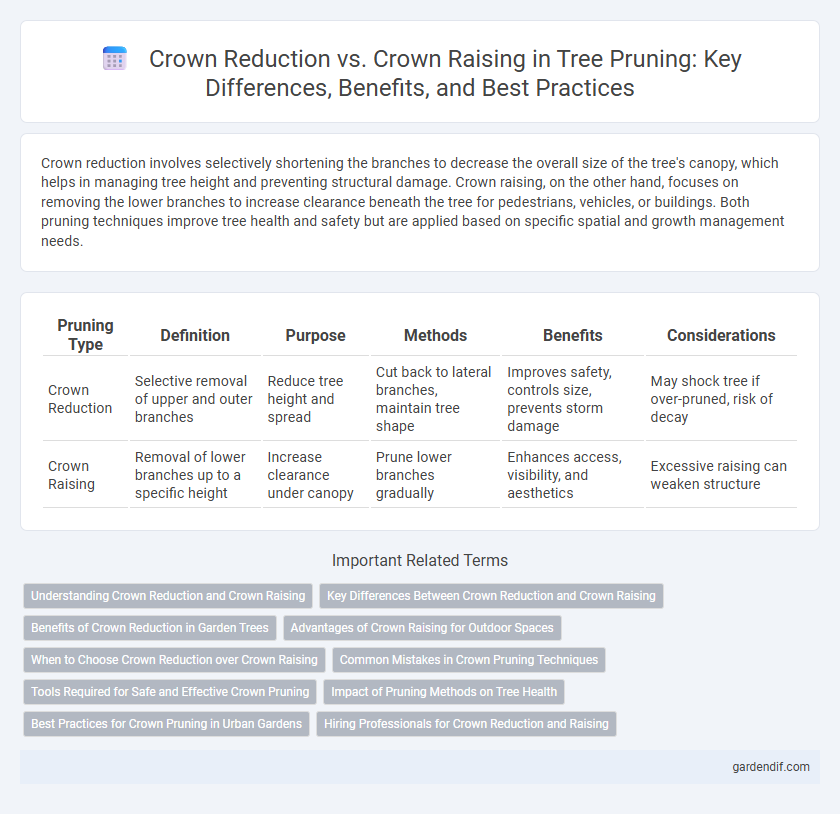
Crown reduction vs Crown raising Illustration
Crown reduction involves selectively shortening the branches to decrease the overall size of the tree's canopy, which helps in managing tree height and preventing structural damage. Crown raising, on the other hand, focuses on removing the lower branches to increase clearance beneath the tree for pedestrians, vehicles, or buildings. Both pruning techniques improve tree health and safety but are applied based on specific spatial and growth management needs.
Table of Comparison
| Pruning Type | Definition | Purpose | Methods | Benefits | Considerations |
|---|---|---|---|---|---|
| Crown Reduction | Selective removal of upper and outer branches | Reduce tree height and spread | Cut back to lateral branches, maintain tree shape | Improves safety, controls size, prevents storm damage | May shock tree if over-pruned, risk of decay |
| Crown Raising | Removal of lower branches up to a specific height | Increase clearance under canopy | Prune lower branches gradually | Enhances access, visibility, and aesthetics | Excessive raising can weaken structure |
Understanding Crown Reduction and Crown Raising
Crown reduction involves selectively shortening branches to decrease tree height and spread, improving safety and structure without compromising tree health. Crown raising focuses on removing lower branches to increase clearance for pedestrian and vehicle passage, enhancing accessibility and light penetration beneath the tree. Both pruning techniques require careful assessment to maintain tree vitality and structural integrity while achieving desired functional outcomes.
Key Differences Between Crown Reduction and Crown Raising
Crown reduction involves the selective shortening of tree branches to decrease overall canopy size, improving tree safety and structural integrity, whereas crown raising focuses on removing lower branches to increase clearance between the ground and the canopy, enhancing access and visibility. Crown reduction alters the shape and density of the upper canopy to prevent hazards like power line interference, while crown raising maintains the natural crown shape but elevates the lower branch height for functional purposes. The key differences lie in their objectives--crown reduction manages tree size and health, and crown raising targets vertical clearance without significantly changing canopy volume.
Benefits of Crown Reduction in Garden Trees
Crown reduction in garden trees significantly improves tree stability by reducing wind resistance and lowering the risk of branch breakage during storms. It encourages healthier growth by directing energy to the stronger, well-placed branches, promoting a balanced structure and improved sunlight penetration. This pruning technique also enhances the aesthetic appeal of trees by maintaining a manageable size without compromising their natural shape.
Advantages of Crown Raising for Outdoor Spaces
Crown raising enhances outdoor spaces by increasing clearance height, allowing better access for pedestrians, vehicles, and garden maintenance equipment. It improves sunlight penetration and air circulation beneath the tree, fostering healthier turf and understory plants. This pruning method maintains the tree's natural shape while creating an open, airy environment beneficial for recreational and aesthetic purposes.
When to Choose Crown Reduction over Crown Raising
Crown reduction is preferred over crown raising when the goal is to decrease the overall height and volume of a tree to prevent interference with structures or power lines while maintaining natural form. This method is suitable for trees that are too tall or dense, requiring size adjustment without exposing lower branches to excessive light or stress. Choosing crown reduction preserves the tree's health and stability by selectively shortening branch length instead of removing the lower canopy.
Common Mistakes in Crown Pruning Techniques
Common mistakes in crown pruning techniques include improper crown reduction that removes too much foliage, leading to tree stress and increased vulnerability to disease, and incorrect crown raising that cuts branches too close to the trunk, causing weak regrowth and structural instability. Over-pruning during crown reduction disrupts the tree's natural shape and reduces photosynthesis capacity, while excessive crown raising can expose the tree to wind damage and sunscald. Proper understanding of branch collar location and maintaining a balanced canopy are crucial to avoid these common errors in crown pruning.
Tools Required for Safe and Effective Crown Pruning
Effective crown pruning necessitates specific tools tailored to crown reduction and crown raising techniques. Crown reduction requires tools such as bypass pruners, loppers, and pruning saws capable of managing larger branches to decrease overall canopy size safely. Crown raising primarily involves using pole pruners and pruning saws to remove lower branches, improving clearance while maintaining tree health and structural integrity.
Impact of Pruning Methods on Tree Health
Crown reduction limits the size of a tree by cutting back branches to reduce height or spread, minimizing wind resistance and preventing structural failure, which supports long-term tree stability and health. Crown raising involves removing lower branches to increase clearance for pedestrians, vehicles, or structures, enhancing air circulation and light penetration, which can improve overall tree vigor. Both pruning methods, when properly executed, reduce stress and prevent disease, but incorrect cuts or over-pruning can lead to decay, pest infestation, and weakened structural integrity.
Best Practices for Crown Pruning in Urban Gardens
Crown reduction and crown raising are essential pruning techniques in urban gardens, with crown reduction focusing on decreasing tree height and spread to prevent overcrowding and damage, while crown raising elevates the lower branches to improve clearance and visibility. Best practices for crown pruning include identifying the tree species' growth patterns, removing no more than 25% of the live crown to maintain health, and making clean, angled cuts just outside branch collars to promote healing. Proper timing, typically late winter or early spring for most species, minimizes stress and disease risk, optimizing tree longevity and urban landscape aesthetics.
Hiring Professionals for Crown Reduction and Raising
Hiring professionals for crown reduction and crown raising ensures precise cuts that promote tree health and structural integrity. Experts assess the tree's condition, species, and growth patterns to perform targeted pruning that minimizes stress and risk of disease. Professional arborists use specialized tools and techniques to safely manage tree height and clearance, enhancing both aesthetics and safety.
Crown reduction vs Crown raising Infographic

 gardendif.com
gardendif.com